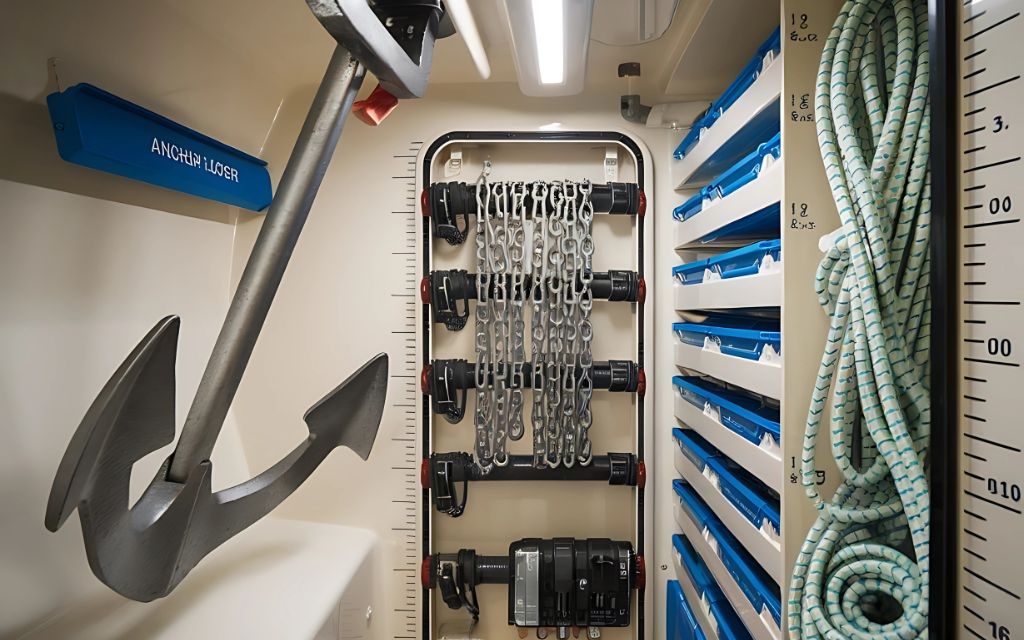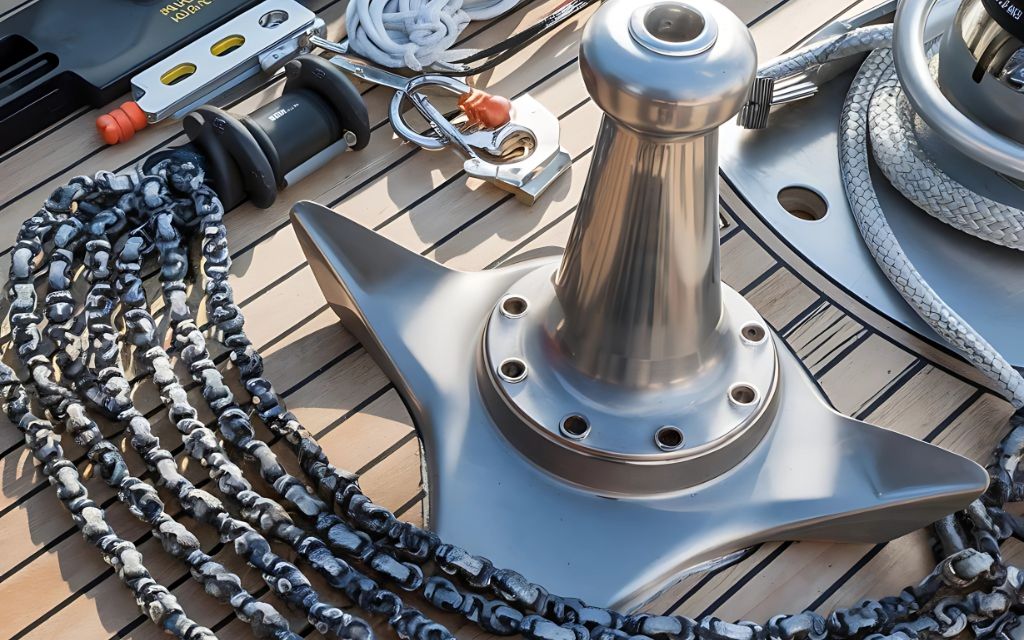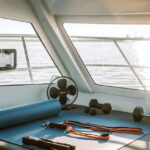Table of Contents
Do you wish to know the tips for maintaining your houseboat anchoring system? Yes, As a longtime houseboat enthusiast and marine maintenance specialist, I’ve learned that your houseboat anchoring system is more than just equipment—it’s your home’s foundation on water.
Today, I’m excited to share my hands-on experience and practical tips to help you maintain this crucial system effectively.
Understanding the Role of Your Houseboat’s Anchoring System
When it comes to safely anchoring boat life, your anchoring system serves as your primary defense against drifting and instability.
The holding power of anchor systems directly impacts your safety and peace of mind while living on the water. Let’s break down the essential components of a typical houseboat anchoring system:
| Component | Primary Function | Maintenance Priority |
|---|---|---|
| Main Anchor | Provides primary holding power | High – Monthly inspection |
| Anchor Rode | Connects anchor to vessel | High – Weekly check |
| Windlass | Facilitates anchor deployment | Medium – Quarterly service |
| Chain/Rope | Ensures secure connection | High – Monthly inspection |
Core Components and Their Functions
The proper anchor rode setup is crucial for maintaining stability. Your anchor windlass usage patterns will determine how frequently you need to perform maintenance checks.
A well-maintained system helps prevent boat drifting and ensures consistent performance in various weather conditions.
Common Problems That Can Affect Your Anchoring System

Living on a houseboat has taught me that anticipating potential issues is key to marine anchor maintenance. Let’s explore the most common challenges you might encounter and how to address them proactively.
Wear and Tear Over Time
Your anchor system guide should include regular monitoring for these common issues:
- Corrosion and rust development, particularly in saltwater environments
- Chain link wear, especially at contact points
- Rope fraying and degradation
- Windlass motor strain and mechanical wear
One critical aspect of anchor and rode care involves understanding how different water conditions affect your equipment. Here’s a detailed breakdown of environmental impacts:
| Environment Type | Common Issues | Maintenance Frequency |
|---|---|---|
| Saltwater | Heavy corrosion, mineral buildup | Weekly freshwater rinse anchor |
| Freshwater | Organic growth, mud accumulation | Bi-weekly cleaning |
| Brackish Water | Combined effects, accelerated wear | Weekly inspection and cleaning |
Anchor Fouling and Performance Issues
To maintain effective anchoring strategies, you need to monitor anchor movement regularly. Fouling occurs when your anchor becomes tangled or catches on underwater obstacles.
Here are my tried-and-true anchor preservation methods:
- Regular inspection of anchor setting techniques
- Proper anchor rode condition check procedures
- Implementation of anchor securing methods
- Consistent monitoring of anchor position
Key Maintenance Tasks for Your Houseboat’s Anchoring System
Routine Inspections
Creating a comprehensive anchor inspection checklist is crucial for vessel anchorage tips. Here’s what I recommend including:
- Weekly Checks:
- Inspect rope condition
- Check chain links
- Verify windlass operation
- Secure rode to bow cleat integrity
- Monthly Assessments:
- Complete abrasion and fraying checks
- Verify anchor weight distribution
- Test power set anchor functionality
- Evaluate anchor deployment strategy
Cleaning and Lubrication Protocols
Cleaning anchor equipment properly is essential for longevity. I’ve developed these boat mooring tips through years of experience:
- Use appropriate cleaning solutions based on your environment
- Implement dedicated anchor cleaning routines
- Apply marine-grade lubricants to moving parts
- Maintain saltwater corrosion prevention practices
Best Practices for Storing and Handling Your Anchoring System
When it comes to houseboat maintenance routines, proper storage and handling of your anchoring equipment can significantly extend its lifespan. Let’s explore the essential practices that will help protect your investment.
Proper Storage Techniques
Your anchor movement monitoring begins with proper storage. Here’s my comprehensive approach to protecting your houseboat anchoring system when it’s not in use:
The key to secure the anchor properly lies in understanding your specific equipment. For optimal marine safety procedures, consider these storage specifications:
- Clean and Dry Storage
- Perform a thorough freshwater rinse anchor procedure
- Allow all components to dry completely
- Store in a ventilated area
- Apply protective covers when appropriate
- Organization System
- Implement proper anchor line handling techniques
- Maintain separate storage for different components
- Label and document your storage system
- Keep maintenance records accessible
Environmental Protection Measures
Saltwater exposure requires special attention to anchor stabilization techniques. Here’s how I recommend protecting your equipment:
- Regular Maintenance Schedule:
- Weekly seawater rinse importance cannot be overstated
- Monthly deep cleaning sessions
- Quarterly comprehensive inspections
- Annual professional assessment
How Often Should You Maintain Your Anchoring System?

Seasonal Maintenance Guide
Your anchor system guide should include specific seasonal tasks. Here’s a breakdown of maintenance priorities:
| Season | Primary Focus | Key Tasks |
|---|---|---|
| Spring | System Preparation | Deep cleaning, component testing |
| Summer | Active Monitoring | Regular inspection anchor procedures |
| Fall | Wear Assessment | Repair and replacement evaluation |
| Winter | Protection | Storage and preservation |
Ongoing Maintenance Requirements
For durable anchoring systems, implement these regular checks:
- Daily Monitoring:
- Visual inspection of visible components
- Basic functionality checks
- Monitor anchor position
- Check for unexpected anchor retrieval needs
- Weekly Tasks:
- Complete holding power of anchor tests
- Verify proper anchor rode tension
- Implement boat anchorage guidelines
- Review anchor windlass usage patterns
Upgrading and Replacing Parts of Your Anchoring System
When to Consider Upgrades
Maintaining effective anchoring strategies requires knowing when to upgrade your houseboat anchoring system components. Through my experience with anchoring safely tips, I’ve identified several key indicators that signal the need for replacement:
The decision to upgrade often relates directly to the holding power of anchor performance. Consider these crucial factors:
- Age-Related Wear
- Components showing significant corrosion
- Reduced anchor windlass usage efficiency
- Compromised proper anchor rode integrity
- Visible signs of metal fatigue
- Performance Issues
- Difficulty to secure the anchor consistently
- Unreliable anchor setting techniques
- Compromised anchor and rode care
- Inconsistent anchor movement monitoring
Selecting Quality Replacement Parts
When upgrading your marine anchor maintenance equipment, quality matters. Here’s my approach to choosing replacements that enhance anchor system guide effectiveness:
Consider these factors for optimal performance:
- Material Quality
- Corrosion-resistant metals
- UV-resistant synthetic materials
- Marine-grade components
- Weather-resistant finishes
- Compatibility
- Proper size specifications
- Weight distribution requirements
- System integration capabilities
- Installation requirements
Professional Help: When to Call an Expert
Recognizing the Need for Professional Service
As someone who values proper houseboat anchoring system maintenance, I’ve learned when to navigate underwater obstacles with professional help. Here are situations that warrant expert intervention:
- Complex Issues
- Windlass motor failures
- Structural mounting problems
- Chain guide complications
- Electrical system integration issues
- Safety Concerns
- Compromised anchor deployment strategy
- Uncertain tidal current adjustments
- Complex anchor position monitoring
- Critical marine safety procedures
Finding Qualified Professionals
When seeking professional help for your boat mooring tips and maintenance, consider these factors:
- Qualifications
- Certified marine technicians
- Experience with houseboat maintenance routines
- Knowledge of saltwater corrosion prevention
- Understanding of mooring system maintenance
- Service Capabilities
- Comprehensive inspection services
- Emergency repair availability
- Maintenance program options
- Equipment upgrade expertise
Conclusion: Ensuring Long-Term Anchoring Success
Successfully maintaining your houseboat anchoring system requires dedication to regular inspection anchor procedures and consistent maintenance.
By following these anchor preservation methods and implementing proper anchor rode condition check routines, you’ll maximize your system’s lifespan and reliability.
Remember these key takeaways:
- Regular monitoring and maintenance prevent major issues
- Quality replacement parts ensure optimal performance
- Professional help can prevent costly repairs
- Consistent care leads to better anchoring experiences
By following these guidelines and maintaining vigilant anchor movement monitoring, you’ll enjoy safer, more reliable anchoring experiences. Remember, your anchoring system is crucial for both safety and comfort on the water – treat it accordingly.
Through proper maintenance, regular inspections, and timely upgrades, you’ll ensure your houseboat anchoring system serves you reliably for years to come. Stay safe on the water, and happy houseboating.
FAQs
How To Anchor A Houseboat?
For most houseboat enthusiasts, the anchoring process begins with finding the right spot and checking the weather conditions.
I’ve learned through experience that you’ll want to approach your chosen location slowly, heading into the wind or current while gradually reducing your speed.
This allows better control and helps prevent sudden movements that could affect your anchoring position.
Once you’re in position, gradually lower your anchor while maintaining minimal forward momentum. From my years on the water, I’ve found that letting out enough rode (typically 5-7 times the water depth) ensures proper holding power. Remember to set your anchor by gently reversing until it digs in firmly.
What Is The Proper Technique For Anchoring A Boat?
The key to proper anchoring lies in understanding the relationship between water depth, rode length, and anchor type.
When I first started boating, my mentor taught me to always check the weather forecast and tidal conditions before dropping anchor.
This preliminary assessment helps determine the amount of scope needed and the best positioning strategy.
Once you’ve chosen your spot, approach it slowly against the wind or current. I always ensure my anchor is ready to deploy and my rode is free of tangles.
After dropping the anchor, slowly back down while paying out the rode until you achieve the proper scope, then set the anchor by applying gentle reverse power.
How To Maintain An Anchor?
Regular maintenance starts with a thorough inspection after each use. During my decades of boating, I’ve developed a routine of rinsing the anchor system with fresh water, paying special attention to moving parts and connection points. This simple step prevents salt buildup and reduces corrosion significantly.
Storage practices play a crucial role in anchor maintenance. I always ensure my anchor is completely dry before storing it in a well-ventilated area.
Monthly inspections of the shackles, chain, and rode have helped me catch potential issues before they become serious problems.
Which Of The Following Should You Consider When Anchoring Your Boat?
Wind direction and strength top my list of considerations when anchoring. Through trial and error, I’ve learned that understanding how these factors affect your boat’s position is crucial for safe anchoring.
Additionally, water depth, bottom composition, and nearby obstacles all play vital roles in choosing an anchoring spot.
Tidal changes and current patterns deserve equal attention. From my experience, failing to account for these factors can lead to dragging or improper anchor setting.
I always check local tide tables and observe current patterns before committing to an anchoring spot.
What Are The Six Steps Of Anchoring?
In my experience teaching new boaters, I’ve found that following a systematic approach works best. The process starts with selecting an appropriate anchoring spot by considering depth, bottom conditions, and surrounding obstacles.
Then, positioning your vessel into the wind or current while maintaining minimal forward momentum sets you up for success.
Next comes lowering the anchor slowly while moving forward slightly, followed by paying out sufficient rode length.
The fifth step involves setting the anchor by gently backing down, and finally, confirming the anchor is holding by using visual references or electronic aids.
What Is The Formula For Anchoring A Boat?
The fundamental formula I use for proper anchoring relates to scope ratio – the relationship between water depth and rode length.
Generally, you’ll want to use a scope ratio of 5:1 to 7:1 for normal conditions, meaning if you’re in 20 feet of water, you should let out 100-140 feet of rode for optimal holding power.
During my years of teaching boating safety, I’ve emphasized that these ratios might need adjustment based on conditions.
Heavy weather might require a scope of 10:1, while protected anchorages might allow for 3:1. Remember to account for tide changes when calculating total depth.
What Should Be Avoided When Anchoring?
From my decades on the water, I’ve learned that anchoring over underwater cables, pipelines, or in designated channels is absolutely forbidden.
It’s also crucial to avoid anchoring too close to other vessels – a mistake I see many newcomers make. Proper spacing prevents collisions when boats swing with changing winds or currents.
Another common pitfall is anchoring on steep slopes or in areas with poor bottom holding. Through trial and error, I’ve discovered that rocky bottoms or heavy vegetation can prevent proper anchor setting.
Always check your charts and consider the bottom composition before dropping anchor.
How Do Boats Stay Anchored?
The science behind staying anchored involves the combination of proper anchor design and sufficient scope.
Modern anchors are engineered to dig into the seabed when tension is applied, creating a strong holding point that resists movement. The weight and design of the anchor work together with the scope of the rode to maintain position.
During my years maintaining houseboats, I’ve observed that successful anchoring depends heavily on matching your anchor type to the bottom conditions.
Sandy bottoms might require different anchor styles than muddy ones. The rode’s ability to absorb shock through its catenary curve also plays a crucial role in keeping vessels securely anchored.
What Size Anchor Do I Need For My Houseboat?
Based on my professional experience, selecting the right anchor size depends primarily on your houseboat’s length and displacement.
For most recreational houseboats, I recommend using an anchor that’s one size larger than what’s minimally recommended – this provides an extra margin of safety during challenging conditions.
The rule of thumb I share with my clients suggests using 1 pound of anchor weight per foot of boat length as a starting point.
However, factors like your typical anchoring conditions, boat width, and windage area might necessitate adjusting this baseline.
I’ve found that having a slightly oversized anchor provides peace of mind without significantly impacting handling.





Pingback: How to Tune Up Your Houseboat Engine oceangrandeur.com